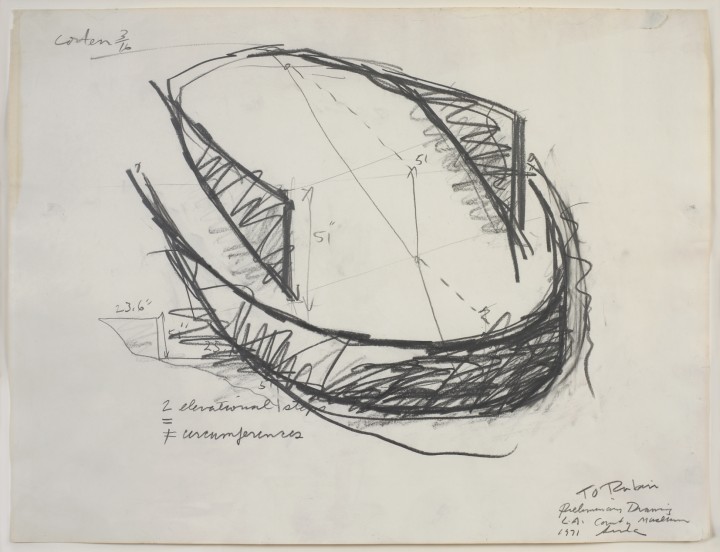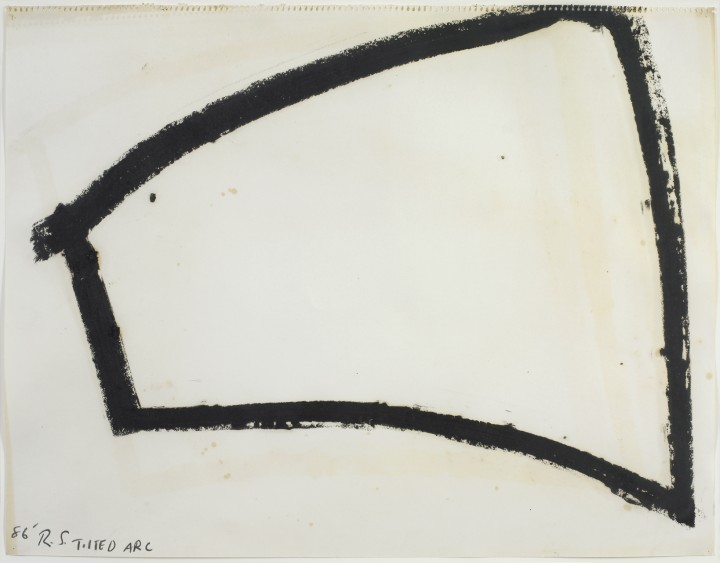Richard Serra
by Jennifer Padgett
Richard Serra may be best known for his massive sculptures, but drawing is fundamental to his artistic practice. In a 1977 interview he explained: “Drawing is a concentration on an essential activity, and the credibility of the statement is totally within your hands. It’s the most direct, conscious space in which I work. I can observe my process from beginning to end, and at times sustain a continuous concentration. It’s replenishing. It’s one of the few conditions in which I can understand the source of my work.”1
Serra’s drawings take various forms, including large swaths of linen covered entirely in paint stick as well as contour drawings on paper. The drawing Tilted Arc (1986; fig. 1) is a prime example of the latter type, with a rounded outline of thick contoured strokes dominating the pictorial space. The drawing relates to Serra’s sculpture of the same title from 1981, commissioned by the US government’s General Services Administration for Federal Plaza in downtown New York. The sculpture was dismantled and removed from the plaza in 1989, after much controversy and public debate.2 Serra made this drawing during the short period in which the sculpture remained in situ; thus it is not a preparatory work but a study completed afterward. This is typical of the artist’s drawing practice. In a recent interview, he explained: “I’m a model-maker. I make models, then the models are translated, and then, after, I make drawings, which is like a whole autonomous body of work. The drawings and the notations are sometimes a reference to ideas of the sculpture, but they’re not representations to be used to make sculpture from.”3
In the drawing, Serra presents Tilted Arc as a bent quadrilateral form in black lines, appearing to push against the upper edge of the sheet. The original sculpture was a rectangular piece of steel, 120 feet long, 12 feet high, and 2 1/2 inches thick. The drawing suggests the sculpture as seen from a viewpoint closer to one end of the piece, as the right edge appears larger in scale than the left edge, but Serra preempted any further illusionistic reading. Instead of depicting the sculpture in space in a realistic way, he used gestural marks to render his physical experience of the work. The figure oscillates between geometric and organic, graphic and painterly, weighty and floating. The dynamic created by Serra in this drawing is related to the effect that he pursues in his sculptural work. He is interested in how the experience of viewing a given work unfolds, as the viewer perceives the forms in real time and space from different angles and distances. The physical experience of his sculptural works is a primary concern for Serra, as he believes that direct interaction engenders in the viewer a greater awareness of the work, the surrounding environment, and one’s place within it.

Figure 2. Richard Serra, Untitled (Preliminary Drawing for L.A. County Museum), 1971
Graphite on paper, 17 3/4 x 23 1/3 inches (45.1 x 59.7 cm)
© 2012 Richard Serra / Artists Rights Society (ARS), New York
Untitled (Preliminary Drawing for L.A. County Museum) (1971; fig. 2) is a rare early example of Serra’s use of drawing in a more traditional sense, as a preparatory medium. As the title suggests, he completed the work as a preliminary drawing for an unrealized sculpture intended for the Los Angeles County Museum of Art (LACMA). The subject is rendered in loose freehand lines, without particular attention to accurate illustration. Two arcs compose a loose elliptical formation in the center of the drawing, with notations, diagrammatic marks, and calculations jotted across the page. The inscription in the upper left—“corten”—indicates COR-TEN steel, which is Serra’s preferred material for large-scale sculpture. The representation of space is disorienting, as the elliptical construction seems to sit on a different ground plane from the step marked “23.6″” directly to the left. While Serra could have used such a drawing as a traditional study—a means of working through the construction of the sculpture—Untitled (Preliminary Drawing) is most effective as a presentation drawing, created to convey the basic idea and form of the project to another individual or group, likely one associated with LACMA.
The capacity of drawing to share ideas and communicate with others relates to Serra’s belief that the medium is a form of language. In 1992 he stated: “Drawing to me is a language that allows me to understand the world, an analytical tool. It is a practical means to assign perception to memory. I understand complexities through drawing, it enables me to grasp them.”4 For Serra, drawing provides a realm for thinking through the issues that concern him most in his practice, its immediacy allowing for a conscious and direct interaction with the forms that he creates.
Notes
1. Richard Serra, in Lizzie Borden, “About Drawing: An Interview” (1977), in Richard Serra, Drawing: A Retrospective (Houston: Menil Collection, 2011), 59.
2. See Harriet F. Senie, The Tilted Arc Controversy: Dangerous Precedent? (Minneapolis: University of Minnesota Press, 2002).
3. “Draw It Black: A Q&A With Richard Serra on His Daring New Retrospective at the Met,” interviewed by Andrew M. Goldstein, Artinfo, April 18, 2011, http://www.artinfo.com/news/story/37489/draw-it-black-a-qa-with-richard-serra-on-his-daring-new-retrospective-at-the-met.
4. Richard Serra, interviewed by Lynne Cooke, May 21, 1992, in Richard Serra: Drawings (London: Serpentine Gallery; Düsseldorf: Richter, 1993), 15.
Bios
Jennifer Padgett
Richard Serra

